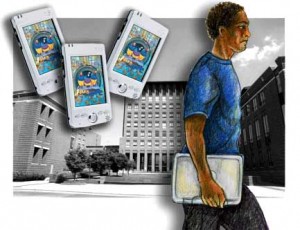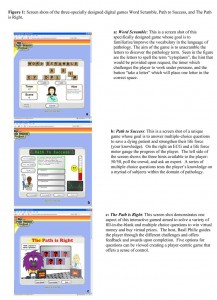Today, many educators and theorists are promoting the benefits of learning through games. With such potential, digital game-based learning seems like a sound investment today and tomorrow. Just Google “game based learning + future” and you come up with a myriad of viable information about where this industry is headed.
Below are just some of the areas that are showing growth in the field.

Homo-Zappiens are the new e-learner generation. They have always lived with the rapid advances of computer technology. One day, this generation will flood the workforce. A generation who grew up with video games. A generation whose split attention span (the New York Times reported that a third of polled people said that they frequently check their email during business meetings) may be incompatible with traditional lectures, manuals, workbooks, videos, and click-through online reading materials. Looking ahead, the BBC has recently invested $350 billion to create an entirely new game-based “digital curriculum”, which aims to engage and motivate the modern learner.
Investing in IT-based Learning Materials
 A current trend of many school is to invest heavily into moving education into the digital age. Along with this movement is the belief that ‘if the hardware is there then the rest will take care of itself.’ Sadly, we are finding this to be untrue. Many schools now have the latest hardware, but no materials to use with it. Fortunately, a new movement is starting.Content is now becoming more important than the latest hardware. Using the iPhone as an example, the phrase, “There’s an app for that” has become common place. Many other companies offer similar hardware, but it’s the content iPhones provide that has made it so successful. So it can be expected that technological industries will continue to put a focus on IT content innovations, including games, rather than new hardware, which schools feel obligated to purchase.
A current trend of many school is to invest heavily into moving education into the digital age. Along with this movement is the belief that ‘if the hardware is there then the rest will take care of itself.’ Sadly, we are finding this to be untrue. Many schools now have the latest hardware, but no materials to use with it. Fortunately, a new movement is starting.Content is now becoming more important than the latest hardware. Using the iPhone as an example, the phrase, “There’s an app for that” has become common place. Many other companies offer similar hardware, but it’s the content iPhones provide that has made it so successful. So it can be expected that technological industries will continue to put a focus on IT content innovations, including games, rather than new hardware, which schools feel obligated to purchase.
Networked Interactivity
 Networked interactivity is a recent innovation that differentiates online educational games from traditional stand-alone CD-based games. Empirical studies show that networked interactivity between learners who play educational games has a positive effect on their feelings of social presence, evaluation of learning (competition, collaboration, satisfaction, and perceived effectiveness of learning method), and test performance.
Networked interactivity is a recent innovation that differentiates online educational games from traditional stand-alone CD-based games. Empirical studies show that networked interactivity between learners who play educational games has a positive effect on their feelings of social presence, evaluation of learning (competition, collaboration, satisfaction, and perceived effectiveness of learning method), and test performance.
M-learning
 Mobile games for learning are already being used in hundreds of projects at higher education institutions. An overwhelming number of game-based mobile applications are available for hundreds of disciplines. As more and more learners are becoming equipped with both a mobile phone and a tablet device, more and more educators have the opportunity to integrate the potential of m-learning into their practice.
Mobile games for learning are already being used in hundreds of projects at higher education institutions. An overwhelming number of game-based mobile applications are available for hundreds of disciplines. As more and more learners are becoming equipped with both a mobile phone and a tablet device, more and more educators have the opportunity to integrate the potential of m-learning into their practice.
 Today, game-based learning environments are becoming more affordable. Consequently, health care organizations and medical schools are beginning to implement virtual reality games and simulations into their training. For example, the FDA now uses virtual reality training for the placement of some of their students. Below are some other examples of games that were developed for medical organizations and business learners:
Today, game-based learning environments are becoming more affordable. Consequently, health care organizations and medical schools are beginning to implement virtual reality games and simulations into their training. For example, the FDA now uses virtual reality training for the placement of some of their students. Below are some other examples of games that were developed for medical organizations and business learners:Word Scramble, Path to Success, The Path is Right
Virtual Forensics Lab
Madden NFL’s Franchise Mode
MMO Games
 Massively multiplayer online (MMO) games allow many players to work together on activities that require collaborative problem-solving. They include a large social aspect and goals to work towards. The challenge of educators is to naturally embed education content into MMO games. Below are two examples of educational MMO games:
Massively multiplayer online (MMO) games allow many players to work together on activities that require collaborative problem-solving. They include a large social aspect and goals to work towards. The challenge of educators is to naturally embed education content into MMO games. Below are two examples of educational MMO games:
AGR Games
 In alternate reality games (ARGs), players search for clues and solve puzzles in an alternate ‘real life’ realm. ARGs provide educators with an opportunity to overlap course content and game play in an entertaining platform. Below are a few examples of educatational ARGs:
In alternate reality games (ARGs), players search for clues and solve puzzles in an alternate ‘real life’ realm. ARGs provide educators with an opportunity to overlap course content and game play in an entertaining platform. Below are a few examples of educatational ARGs:
World Without Oil
Superstruct
The Tower of Babel
Burgess, A. Virtual Forensics Lab. Boston College. Retrieved online September 26th, 2011 from http://idesweb.bc.edu/forensicslab/
Chinn, P. (2009). Playing for a Good Grade. IT Connections. Retrieved online September 26th, 2011 from http://it.uoregon.edu/itconnections/playing-for-a-good-grade
Chubb, P. (2010). Apple Trademarks Tagline ‘There’s An App For That’ At Last. Product Reviews. [image]. Retrieved online September 26th, 2011 from http://www.product-reviews.net/2010/10/12/apple-trademarks-tagline-theres-an-app-for-that-at-last/
Costik. (2009). Real Lives 2010. Playthisthing. [image]. Retrieved online September 26th, 2011 from http://playthisthing.com/real-lives-2010
Egenfeldt-Nielsen, S. (2011). Future of Game-Based Learning [Blog]. Retrieved online September 26th, 2011 from http://egenfeldt.eu/blog/category/discussion-gbl
Johnson, L., Smith, R., Willis, H., Levine, A., and Haywood, K., (2011) One Year or Less: Mobiles. The 2011 Horizon Report. Retrieved online September 26th, 2011 from
http://wp.nmc.org/horizon2011/sections/mobiles/
Johnson, L., Smith, R., Willis, H., Levine, A., and Haywood, K., (2011) Two to Three Years: Game-Based Learning. The 2011 Horizon Report. Retrieved online September 26th, 2011 from http://wp.nmc.org/horizon2011/sections/game-based-learning/
Kanthan, R. & Senger, J. (2011) Digital Games as Educational Tools for Medical, Dental, and Physical Therapy Students. Journal of the International Associaton of Medical Science Educators. [image]. Retrived from http://iamse.org/artman/publish/printer_484.shtml
Kanthan, R. & Senger, J. (2011) Digital Games as Educational Tools for Medical, Dental, and Physical Therapy Students. Journal of the International Associaton of Medical Science Educators. Retrived from http://iamse.org/artman/publish/printer_484.shtml
Kanthan, R. & Senger, J. (2011) Impact of Specially Designed Digital Games-Based Learning in Undergraduate Pathology and Medical Education. Education in Pathology & Laboratory Medicine. Vol. 135. Retrieved from http://www.ctsi.ufl.edu/2011/01/13/the-impact-of-specially-designed-digital-games-based-learning-in-undergraduate-pathology-and-medical-education/
Kwan, M., Jeong, E., Park, N. & Ryu S. (2007). Effects of Networked Interactivity in Educational Games: Mediating Effects of Social Presence. Presence. Retrieved from
http://www.temple.edu/ispr/prev_conferences/proceedings/2007/Lee,%20Jeong,%20Park,%20and%20Ryu.pdf
Lohr, S. (March 25th, 2007). Slow Down, Brave Multitasker, and Don’t Read This in Traffic. The New York Times. Retrieved from http://www.nytimes.com/2007/03/25/business/25multi.html?pagewanted=all
Machado, J. L. (2000). Tecnologias nas Escolas. Intersubjectiva. [image]. Retrieved online September 26th, 2011 from http://www.planetaeducacao.com.br/portal/artigo.asp?artigo=1333
Meyer, W. (no date). Interaction Design Projects. [image]. Retrieved online September 26th, 2011 from
http://www.telehaptics.com/
mlearning2010. (2010). Mobile learning: Technology that will take the classroom into the world. Wikispaces. [image]. Retrieved online September 26th, 2011 from http://mlearning2010.wikispaces.com/
References for Business. (2011). Virtual Reality Computer Simulations. Encyclopedia for Business, 2nd addition. Retrieved online September 26th, 2011 from
http://www.referenceforbusiness.com/encyclopedia/Val-Z/Virtual-Reality-Computer-Simulation.html
Trybus, J. (2009). Game-Based Learning: What it is, Why it Works, and Where it’s Going. New Media Institute. Retrieved from
http://www.newmedia.org/game-based-learning–what-it-is-why-it-works-and-where-its-going.html
Waite, J. (2007). World Without Oil: The Post-Game Press Release. ARGnet. Retrieved online September 26th, 2011 from http://www.argn.com/2007/07/world_without_oil_the_post-game_press_release/
Wordle Contribution
So what’s your take? Where do you think digital game-based learning for adults is headed? Please make sure you add your thoughts to the comment section below.

Digital game-based learning is headed in the direction of training and development for adults. There are a number of categories of game based play, but they will become tools in the toolbox of an adult educator that employs game based play (such as m-learning).
Thanks for your input Kristopher.
Do you think most adults will be able to get past the “childish” stigma that surrounds games? And, if so, what is required in an adult training game to make it an educational and entertaining “tool”? What appeals to adult gamers?
To answer one of the questions…
I think that, as alluded to in the Homo-Zappiens section, when this pro-gaming generation grows up, I think a lot of the “childish” stigma will be erased. I know that, as a casual gamer myself, I don’t think of gaming as necessarily childish or useless.
Game-based learning has it’s place in training and knowledge development in certain fields (i.e. medical) and can be an effective problem-solving skill development tool but I am cautious to say that all learning move in this direction. Not all learner’s are engaged in this manner, but as Kristopher mentions it will become increasingly important as society moves more and more into mobile learning.
Good comment Jay.
There is no “one-size-fits-all” solution in education. DGBL won’t appeal or work for everyone and every field. Aside from medicine, what are some other field that are (or arguably, should be) implementing DGBL? Where is DGBL a good fit?
I used medicine because I think game-based learning in this area allows students to practice complicated procedures without life or death consequences however I don’t think there is any game that could duplicate the experience and context of the real situation such as the stress someone is under during such a procedure.
I think the fit is not dependent on the field, but rather the learner (although I would argue that there may be certain fields that in which it may be more appropriate). What DGBL cannot provide in learning is dealing with the unpredictability in human respones and reaction in particular situations but this does not mean it cannot build problem-solving and critical thinking skills in learner across many different fields.
Hi Jay.
I’ve read that some medical simulation games include ‘profs’ asking you intense questions while you’re trying to solve other problems in a time dependent situation, stressful ‘real life’ simulation. But, I agree that it would be very difficult for a simulation to ‘accurately’ react to the “unpredictability in human response.” Though, I sometimes try to avoid the word ‘never’ when it comes to technology.
Game-based learning is a challenging new frontier! I do not think we have full-realization or exploration of the opportunities that truly exist with this technology. It has the potential to reach individuals at their own level and where they are at in their learning paradigm. Always an interesting discussion point!
Thanks Deb.
Many DGBL activities allow learners to set their own challenge levels, which can really help to target individual needs. But, GBL has been talked about as the “new frontier” for a long time. Why do you think we are seeing more and more DGBL today?
Although I feel more qualified to comment on game-based learning at the K-12 level, I guess some aspects overlap. For one, in order for a greater adaptation of simulation/real world approaches in higher educational settings, traditional modes of assessment will need to change. As well, the idea that all students need to follow one learning pathway to regurgitate a pre-determined bolus of content will not necessarily hold true, especially in areas outside of training. Focus will shift from content to process, and innovative approaches such as game-based learning will be ideal to foster the social and collaborative skills that the future will demand.
Thanks Karen.
When you think about what is already possible with virtual reality training and MMO educational games, it’s amazing to think about how cooperative problem solving could be done in the future. Also, with all the apps that are becoming available, there are more and more ways to approach and learn content. So, if educators continue to embrace DGBL, how do you think “traditional modes of assessment” will change?
As much as I am not personally engaged in gaming, I hear over and over again how much of an impact educational games can have in student learning. I feel as though I haven’t given this learning format a fair shake..perhaps I have not “played” enough with a wide enough variety of games to see the potential..I sometimes feel that I have missed the speeding train. There are so many researchers and expert educators who believe in gaming as an outstanding way to engage learners.
Thanks bcourey.
After hearing about the positives of educational games, what do you think it would take for you to give educational games “a fair shake”?
As a “non-gamer” I was most fascinated by Jane McGonigal and Adaptive Games. Kind of like reality TV shows…like the 100 Mile Diet, or Til Debt Do us Part…..these games connect “real people” with “real issues”. I like that they are taking the stigma out of being a gamer…..I listened to the whole 20 minutes of McGonigals’ TED talk from another part of your project. Thank you for including such an extensive collection of “gaming” examples….Educational can mean, “lifelong education” as well…the money in possible ventures surrounding these types of games may mean reaching out to a broader market. Good for you guys for pulling this all together!
Thanks Verena.
What are some markets that you feel future ventures should tackle? Is there any topic or type of game that could covert you into a “gamer”?
I think adult game based learning will contain very highly focused content or skills. In the education market, adult learners will use simulation games far more than other types of games. Any context in which a safe learning environment can be designed from a potentially dangerous real life environment is a candidate for an educational simulation. For example, flight simulators, surgery simulations and firefighting technique simulations have all been successfully used as simulation games.
In the future, I can see simulation games that involve environmental disaster simulations or world-wide epidemic simulations that could challenge professionals with situations and decisions before the event occurs. Simulations could also be designed for citizens if these kinds of problems become more common or frequent.
I completely agree, Jim.
I am also amazed by the potential for distant professionals to be engaged in dangerous simulations online. A wealth of knowledge can be exchanged in real time in “real” situations. It can take training and apprenticeship to whole new levels.
What differentiates a Homo-Zappien from a digital native? Just the fact that one “zaps” or plays games? Either way, once this generation grows up, notions of gaming as being more recreational than anything else will open up. Soon, the “workplace” will become the “create-place” or “professional sandbox” of sorts. A place where people create, collaborate, problem solve, and “play” – but get paid for it.
Investing in IT for organizations (schools included) is hard… when you always want to be on the cutting edge, where people are going to grow and learn the most (like the technological / hardware branch of Jame Paul Gee’s idea we read about, where students learn best at the edge of their abilities – the ‘regime of competence’ principle). Hopefully the actual shift is as mentioned – towards a focus on content rather than just technological advancement.
The short section on networked interactivity was interesting, and not altogether surprising. It brang to mind the theories behind it that would make it as strong as it is / could be. For example, just under social learning theory, for starters:
Activity Theory (Vygotsky, Leont’ev, Luria & Engstrom), Distributed Cognition (Hutchins), and Situated Cognition (Lave), Social Cognitive Theory (Bandura)
I think the strength of M-learning is not so much that it’s mobile as much as it is more accessible to people all over the world, especially in less-developed countries.
With regards to simulators and and virtual reality, I think they are some of the best games for learning. They involve trial and error, where the players learn from mistakes with often instant feedback. They can be very deep, like the general manager mode of a sports game, or more whimsical like The Sims franchise (which I haven’t played since my mad scientist character was eaten by his venus flytrap).
Thanks mcquaid.
Do you think the “professional sandbox” you describe will occur naturally as a generation matures, or will certain obstacles need to be overcome before games are widely accepted in the ‘work place’?
I think it will be a mix of both, but I think obstacles that exist currently will be seen as more necessary to eliminate in the eyes of those new workers / creators.
Gaming involves strategising, application of and learning new skills as well as in some instances forming allies/working teams. Such attributes are far from childish and as such should be taken seriously in the potential of educational gaming. I support the idea but my questions surround: cost, cost and cost, for research and development, ease of modification for specialised and individualised context. A user friendly model and platform is necessary for incorporation by general educators.
Thanks khenry.
When it comes to cost, I read that many medical institutions are getting on board with DGBL because a simulation program is easier to purchase and distribute than lab time, expert time, and travel time. But I’m sure there are many more examples, and counter examples, regarding DGBL and cost. Will it help costs in the future?
Most of the games that adults play these days are somewhat related to the REAL world. Throughout these virtual reality games, adults can experience and face situations that can be likely to happen in the real world. Moreover, we can put ourselves into someone else’s shoes by playing these kinds of games. For instance, through the SPENT game you introduced, I experienced in a roundabout way how difficult it would be to make a living if I was unemployed and had dependents to take care of.
Deb
I think the future of game-based learning will be like the new Sesame Street game “Once upon a monster”. This type of game allows the gamer to get into the game and I think this will be the future. Soon we will get right into the game and the characters and the environment will directly respond to our actions. Through this type of immersive learning, the user can really start to learn complex topics in a safe environment.
Juliana.
Juliana.
I also believe that game-based learning does has its place in the educational field- in a variety of settings and promoting a variety of goals that are trying to be accomplished.
I really enjoyed your presentation week. Thanks for all the wonderful information!!
Sorry this is a late post, I wasn’t able to get on the computer yesterday.
Cheers,
Jen
Thanks for the wonderful presentation.
My opinion is that game based learning is only going to increase. The social stigma that used to exist in gaming seems to be decreasing. The gender gap is shrinking and technology is being used more in the classrooms. To me this is the perfect storm for video game based learning. This is especially true with the adoption of video games on previously non-tradition platforms such as cell phones and tablets.
Great presentation.
David.